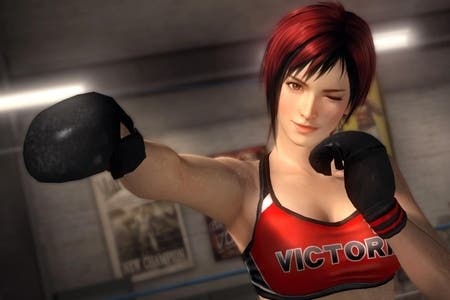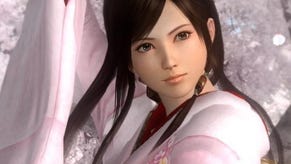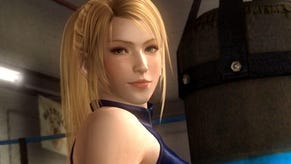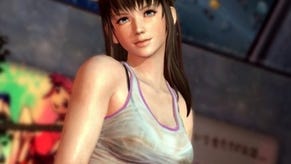Dead or Alive 5 review
Tina arena.
If a fighting game sequel is going to be a critical and commercial success, it has to offer tangible progression for a wide variety of players. For dabblers who tend to dismiss the online arena in favour of solo modes and local multiplayer, the new iteration needs to deliver an enticing range of new characters, a cosmetic upgrade and a weighted helping of single-player content that lasts more than an afternoon. For ardent fans, the mechanical changes need to strike an even balance between familiarity and innovation.
This last point is particularly tricky, because if you add something that's redundant, cheap or gimmicky, you risk unbalancing an otherwise stable foundation - but by the same stretch, if you release a fighting game that handles almost identically to its predecessor, you risk a backlash of apathy.
Dead or Alive 5 appears to understand this dilemma without finding a conclusive way to solve it. It doesn't tarnish the series' solid and sassy reputation - far from it - but it falls short of an evolutionary leap in terms of combat mechanics and a substantial expansion in terms of single-player distractions.
If you've ever performed a combo throw with Bass Armstrong or juggled like a pro with Jann Lee, you'll be instantly at home with the four-button layout that fuels the underlying triangle system. Strikes stuff up throw attempts, throws punish mistimed holds and holds turn the tables on predictable strikes.
The Dead or Alive series has always been counter-centric with an upbeat tempo, as even when reeling from a punch to the chest or a kick to the shins, you can reverse the flow in an instant if your feet are still grounded. You have to watch your opponent like a hawk while keeping your own movements unpredictable because, more so than in most other fighting games, just about every action is easily punishable. In this regard, Dead or Alive 5 keeps the safety off while introducing a handful of interesting mechanics.
"DOA5 doesn't tarnish the series' solid and sassy reputation - far from it - but it falls short of an evolutionary leap in terms of combat mechanics and a substantial expansion in terms of single-player."

The most basic is the new Power Blow system. Every time your character dips below 50 per cent health, you'll gain access to a chargeable attack that can catapult the opponent backwards as if they'd just been hit by a wrecking ball. You also have some control over where they land; by aiming for one of the stage-specific Danger Zones - which range from a row of explosive barrels to a circus cannon that's hidden behind an eerie clown face - you can quickly level the playing field. But while the Power Blow is fairly limited in terms of combo creation, the new Critical Burst mechanic is much more intrinsic.
Every strike landed deals stun, and when enough stun has been dealt in an unbroken combo, you can land a Critical Burst attack that crumples the opponent while leaving them temporarily helpless as you pile on the damage. The key thing about Critical Burst is that it removes the ability to hold while in a grounded state. You can vary your strikes to build stun, land a sneaky Critical Burst, follow it up with a string that ends in a launcher and then juggle as many hits as you can manage before bouncing your hapless opponent off the arena wall for scary damage.
It's no more revolutionary than the Bound system from Tekken 6, but it's still an elegant addition to an already refined combat formula. The same is also true of the new Story mode that gives Dead or Alive 5 a bit more bite in the solo stakes. It's split between 19 chapters that each focus on a single character. That amounts to around three fights per head, and while the many cut-scenes deliver a narrative that's as barmy as it is wooden, each fight has a bonus objective that encourages you to learn the individual mechanics at a relaxed pace.

By the time you've seen the end credits some six or seven hours later, you should have a comprehensive understanding of the fundamentals. Playing through the Story mode also unlocks Gen Fu, who we haven't played since Dead or Alive 3, in addition to a trio of characters from Sega's legendary Virtua Fighter series. Pai Chan makes the cut with her raw speed and palm strikes, Sarah Bryant fits in with her sleeveless leather jacket and devastating kicks, Akira gets an expert hold that lets him parry high attacks for a free follow-up, and all of them look fantastic in motion.
Returning characters include the drunken antics of Brad Wong, the loud-mouthed Muay Thai skills of Zack and the super shinobi talents of Kasumi, Ayane, Hayate and the ever-popular Ryu Hayabusa. There are even two genuinely new fighters in the form of Mila and Rig. The former is an MMA fighter that can take the fight to the ground with armbars and triangle chokes, while the latter forgoes advanced holds and throws for an all-out taekwondo offensive that includes a flamingo stance and vicious roundhouse kicks. The 24 characters are all animated to a pleasingly high standard, although some of them appear to be suffering from a Botox overdose that strips the emotion off their porcelain faces.
Fans will also be pleased to hear that Tag Match mode has been reinstated. It's nowhere near as sophisticated as Tekken Tag Tournament 2, but in terms of letting you combo back and forth between your two chosen characters, the system is functional, if unremarkable. This can also be said of the remaining game modes. Apart from Story mode you get a decent Training room with the usual dummy settings and recording options in addition to a fairly tepid spread of Versus, Arcade, Time Attack and Survival modes.
"The 24 characters are all animated to a pleasingly high standard, although some of them appear to be suffering from a Botox overdose that strips the emotion off their porcelain faces."

The only other single-player distractions are an album that lets you take photos during a saved replay and a collection of 524 titles. These can be earned by meeting simple tasks like clearing Arcade mode on the champion difficulty setting, as well as surmounting more demanding challenges like winning 3000 online battles with the dainty Kokoro. It's a shame that Team Ninja hasn't gone the extra mile by including some character-specific combo trials, as this would've been a useful feature for newcomers and diehards alike.
But in terms of the online modes, Dead or Alive 5 features everything from player and ranked matches to customisable lobbies, filterable leaderboards and a Fighter List feature that lets you register online players so you can download their AI data and fight them in the future. Unfortunately, we still haven't been able to test the game's online stability at the time of writing; based on Team Ninja's track record, we suspect that the online experience will be short of the benchmark but still more than playable. And considering the addition of an Online Pass Code, we hope that the netcode justifies the tax on second-hand sales.
Whether you'll want to buy Dead or Alive 5 on day one depends on a number of things. If you're looking for a wealth of new and inventive content in addition to some truly ground-breaking mechanics, then this really isn't the next big thing. But if you have any love for the genre and want to lose yourself in a highly methodical 3D fighting game that tests your adaptive reasoning at about three or four potentially game-changing decisions per second - well, then Dead or Alive 5 is very easy to like.





